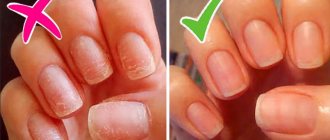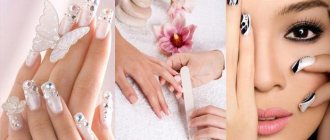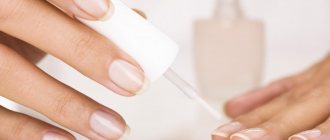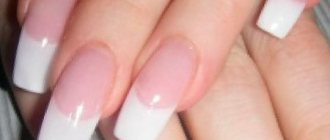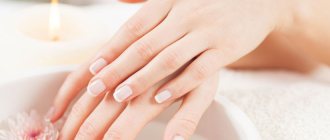When doing extensions, every girl hopes that beautiful nails will please her for as long as possible. However, not everyone and not always have artificial plates that remain unchanged for the same long time. At the same time, this period can differ from person to person by almost two times. Below we will consider how long extended nails last and what determines the duration of this period.
[yandex1] [google1]
general information
When building up, the own plate is cut down quite significantly. Instead, a new one, gel or acrylic, with an elongated free edge is essentially formed. If done according to all the rules, such a plate can last up to half a year (of course, if it is used correctly).
Three to four weeks after the extension, the time for correction comes. It is determined by the precuticular zone of the nail. As soon as a noticeable area has formed near it, as a result of regrowth, not covered with gel, it’s time to go to the specialist. If the condition of gel nails is not neglected and the regrowth is insignificant, then there is no need to remove the nail and build a new plate. If the correction is carried out in a timely manner, the master can quickly eliminate all detachments and prolong the life of the nail.
Thus, correction can be performed up to four to five times. After this, the gel begins to deteriorate for reasons beyond your or the master’s control and the nails must be removed in order to then grow or not grow new ones. Thus, how long the extended nails last depends on the correctness and timeliness of the correction.
In addition, this factor largely depends on the rate of nail growth. If nails grow very slowly, then correction can be carried out every five to six weeks. Thus, the extended plates will last up to six months. If nails grow very quickly, correction may be required after 14 days. In this case, all four to five corrections will be completed in three months or less.
[yandex2] [google2]
Advantages and disadvantages
This procedure evokes extremely positive emotions in most girls. However, nail extensions have pros and cons that are important for everyone to know about. It is from these that some possible risks arise.
pros
The benefits of nail extensions seem obvious. In fact, their number is much greater than it seems. These include:
- Naturalness. The new plates look like natural nails.
- Persistence. Manicure on plates lasts at least 3 weeks.
- Protection. Artificial coating protects nails from harmful substances.
- Beauty. The plates can be decorated as you wish, making them incredibly beautiful.
- Disguise. Extensions allow you to hide visual defects of natural nails.
This is enough to interest any girl in the procedure. But you should always think in advance about possible negative consequences.
Minuses
There is nothing that is without its shortcomings. When building up, everyone still faces the negative side. What can a girl expect:
- Damage to natural nails. When artificial plates are removed, cosmetic damage remains on their own.
- Risk of harm. Under certain conditions, nail health may be harmed.
- The importance of the master's skills. If you entrust the work to an inexperienced person, you can seriously damage your nails.
- A number of contraindications. If you are pregnant, have fungus on your fingers, have wounds or have plate injuries, you will not be able to attend this procedure. If you have diseases of the endocrine, digestive or excretory systems, as well as taking certain medications, artificial modeling is also prohibited.
As a rule, people turn a blind eye to such shortcomings. Only a few give them meaning.
Causes of detachments
But not everyone’s nails last as long as stated. What nail extensions look like and how long they last can vary from one person to the next, even if they have the same artist perform the procedure. If you notice that your nails begin to peel off or crack and become dull within seven to ten days after extensions, then this can happen for several reasons.
- Error or negligence of the master. Skipping any important stage and other simplifications (reducing the cost) of the technology always harm the appearance and sustainability of the manicure. However, the effect will be the same if any of the stages are performed poorly. For example, the plate is unevenly sanded, the bond, primer or gel is poorly applied, there are errors in calculating the nail architecture;
- Various violations of the rules of operation on your part also affect how long you can wear extended nails. More details about the operating rules will be written below;
- The presence of infectious or inflammatory diseases leads to the fact that the material begins to be perceived as foreign and is rejected by the body. As a result of this process, detachments and chips occur in the gel;
- The presence of nail diseases, fungus, psoriasis or other deviations from the norm leads to the fact that the lifespan of the extension will be minimal. The same applies to brittle, thin, weakened and peeling plates. With such nails, extensions are not recommended at all;
- Performing a manicure immediately before extensions can also cause early detachments or cracks. It is better to cut the cuticle and do similar procedures at least a day or two before extensions. During this time, the nail will have time to adapt and recover from the process;
- Taking antibiotics and medications of certain pharmacological groups also leads to the fact that the nails peel off, or even completely, the gel completely comes away from the nail. In this case, the gel is also perceived as a foreign material and is rejected. Particular difficulties in this regard can be presented by drugs that accumulate in the nails;
- How long you can wear extended nails also depends on your hormonal status, both during the extension and while wearing it. That is why many specialists do not recommend performing the procedure during menstruation, as well as in the early and late stages of pregnancy and immediately after childbirth. With sudden jumps in hormonal levels, a phenomenon similar to what occurs when taking antibiotics is observed.
Thus, there is no exact time limit for how long you can wear extended nails. The duration of this period depends on many factors. And sometimes, you yourself can become the reason for the short life of your manicure.
[yandex3] [google3]
The truth about professional nail extensions!
Many people think that false nails are only a few years old. However, this is not at all true.
Back in Ancient China, people learned to create nails from silver, egg whites, wax and a special gelling substance - “agar-agar”. In Europe in the Middle Ages, another person's nails were used to achieve a similar effect. Of course, there was no talk of any naturalness. A little later, nails made from flax began to appear. Of course, paper nails were also a hit. However, the most popular, thanks to Gretta Gabro and Marlene Dietrich, were false nails made from film.
Until the thirties of the 20th century, not all women could boast of beautiful and long nails. In the seventies and eighties, women, especially in the United States, wore their nails to extraordinary lengths and painted them with multi-colored polishes. This became possible with the invention of various methods of nail lengthening, such as the acrylic technique or modeling with easily and quickly hardening synthetic substances.
An amazing method that literally saved many women in the 21st century and turned their hands into well-groomed and beautiful ones was discovered completely by accident. Today, the mystery of the appearance of false nails has become overgrown with speculation, but what is known for sure is that they were invented by an American dentist, who quite accidentally used acrylic to join an unsuccessfully cut nail. The moment Fred Slack realized his discovery, he closed his practice and founded the first company, which introduced a new product to the market in 1951: acrylic false nails.
Alas, not all of us are happy owners of beautiful natural nails. And in this case, the surest way out is extension.
Nail extensions are the most convenient way to quickly get a great manicure. However, not all extension options are safe. How to choose the right technique and care for artificial nails?
Acrylic and gel extensions are carried out using various technologies. With gel extensions, the nail plate is covered with gel, then dried under an ultraviolet lamp.
Acrylic extensions do not require exposure to ultraviolet light.
In gel and acrylic, the base is the same “acrylates”, with the only difference being: the volatile hardener, which creates a pungent odor during acrylic extensions, was removed from the gel, and replaced with a stabilizer, which is destroyed when exposed to ultraviolet light.
Gel nails consist of 60% resin from coniferous trees. They have been proven to be completely safe for health
Is the extension single-phase or three-phase? The difference lies in the difference in the gels. Single-phase gel requires one or two applications, then liquid glass for shine. This works very well for short, natural looking nails. Three-phase gel consists of three types of gels and is applied in three layers, sequentially in each phase, and is used to more significantly lengthen the free edge of the nail.
Method of nail extension using tips or forms.
When extending nails using tips: the overgrown nail is cut off and lengthened with a tip (glued with a special glue), gel or acrylic is applied on top.
When extending nails on forms: the regrown nail is preserved, a form is placed under it and your own nail is lengthened with gel or acrylic. Extensions on forms are much more reliable, the material lasts longer and is stronger.
Strengthening nails with gel or acrylic:
Nail strengthening is done on top of your own nails. Those. The length and shape of the nails are preserved, but they are simply given strength and shine. Can be covered with any coating and lasts for 3-4 weeks until the next correction.
In order to maintain the healthy appearance of natural nails, it is necessary to strictly adhere to the technology, because technology is an algorithm of sequential actions leading to a pre-guaranteed result. Thus, subject to technology, the use of certified materials and compliance with the rules for the use of abrasives, the master does not harm the natural nail, but only helps a person gain self-confidence, thanks to the impeccable appearance of hands with well-groomed nails.
Nail extensions done professionally cannot affect your nails in any way; modern nail extension technologies are no more harmful than nail polish.
Pay attention to prices and services; quality material cannot be cheap. When applying acrylic extensions, pay attention to the MMA (methyl methoacrylate) content - it should not be there. Do not allow the nail plate to be heavily filed before applying nail extensions; no drills!!! - light shine removal only. "Mechanical degreasing of the nail plate"
If you use the services of professionals, you will make corrections on time. You can forget about the need for a weekly manicure, which lasts only a few days.
As a rule, it is not bad materials that spoil nails, but bad masters!!! So don’t make a mistake when choosing a master, it’s good – it’s never cheap!!!
Contraindications for nail extensions:
Nail extensions should not be done if
You are undergoing chemotherapy or taking antibiotics (because the body releases substances that promote the rejection of extended nails).
Nails cannot be extended if they are affected by a fungal disease.
It is not advisable to do nail extensions during pregnancy and breastfeeding.
Age less than 18 years
For diabetes or psoriasis,
If you have chronic intestinal diseases.
Unfortunately, it will be difficult to keep your nails in place. The natural rejection process will operate due to the fact that your body secretes the so-called natural acetone. Be prepared for the fact that correction will need to be done every 2 - 3 weeks.
Now let's look at the most frequently asked questions when doing nail extensions:
What is correction?
Your nail gradually grows and a strip without acrylic (gel) forms near the cuticle. In addition, as the nail grows, the stress zone also moves. Therefore, in order for the nails to continue to look well-groomed, it is necessary to make corrections once every 3 to 4 weeks.
How do false nails spoil natural nails: do they become thin, brittle and stop growing?
If we are talking about the work of a bad master, then it is difficult to disagree with this. Peeling of artificial coating from natural nails is a consequence of many reasons associated with poor quality of work. Often such “professionals” offer clients to purchase glue for gluing false nails, which further aggravates the problem. In this case, due to the greenhouse effect, bacterial growth increases. False nails require special treatment on your own nails. Careless or improper treatment causes microtrauma to the nails. They get a bacterial infection and can develop a fungal disease. The destruction of the nail begins. The nail plate peels off from the nail bed. The nail begins to turn yellow, blacken, thicken, and crumble. If the growth zone is affected, the nail stops growing or grows incorrectly. Deformation of the nail plate can ultimately lead to nail loss. And this is not only a cosmetic, but also a physical defect.
Another common example of harm is the “products” of unfortunate masters who learned how to do nail extensions, who knows where and how. Alas, it is not so much chemicals, but rather the “human factor” that causes the greatest damage to nails. For example, unprofessional removal of artificial nail polish can damage natural nails. If a nail extension artist is not a professional in his field, then he can cause harm. There are several common mistakes made by bad craftsmen that you should pay attention to. The most basic is improperly filed tips or natural nails.
Unprofessional nail technicians spoil their nails by using strong sawdust and using low-quality materials.
Is it possible to get rid of ingrown toenails using toenail extensions?
Yes this is true. In the USA, there has long been a patented method for correcting such nails, which is called stop-n-grow. With the help of special plastic devices, the role of which is played by pieces of tips, the correct direction of nail growth is set. Then the nail and tips are covered with acrylic or gel. The technique is very popular and can save a person from such a problem for a long time, or even forever.
My nails don't breathe under artificial ones?
Many people believe that when wearing artificial nails, a break is necessary to allow them to “breathe.” This is an incorrect assumption. Nails are keratinized - dead tissue - and do not require air. If you use quality materials and turn to professionals, your nails can be worn for a very long time.
What nail lengths are possible? The choice depends on your type and desire. But you should adhere to the basic rule of lengthening with artificial tips: the nail extension, that is, the edge extending beyond the natural nail bed, should be shorter than the nail bed itself. It is optimal if the tip is half as long as the nail. Otherwise, the nail may break off. If you are not used to long nails, then it is better to start with a short length.
What if I bite my nails? Will extensions help cope with this?
There are many ways to help deal with this problem. Adults are recommended to have their nails extended, that is, to cover them with artificial covering. Since artificial nails are harder than natural nails, they will help you break the habit of biting your nails. If you try, you can, of course, bite them off, but the cost of replacing one, or even all nails will stop many. An unpleasant, bitter taste will provide additional assistance in this regard.
Children benefit greatly from weekly manicures and especially nail designs. In this case, children are afraid of spoiling it, they value it and do not dare to bite their nails.
Are artificial nails durable?
Yes, because an acrylic or gel nail is 50 times stronger than a regular natural nail. But, nevertheless, it is better not to use them as a screwdriver.
How long can you walk with them? The materials used also influence how long nails are worn. Chinese tips, gels and acrylics are usually attractive due to their price. They are very inexpensive and are in the lower budget price range. Their use may cause customer dissatisfaction with the quality of nails. Which will lead to the client turning to another master. The quality of nails made from poor materials can be recognized with the naked eye.
The duration of wearing artificial nails made of acrylic and gel is directly influenced by the quality of the nail plate on which they are applied. At the salon, during the client’s first visit, they usually conduct a nail diagnosis. This procedure helps determine the duration of wearing artificial nails. The artificial material will last long enough if the nail plate of the natural nail has a thick keratin layer.
Some lovers of artificial nails have been wearing them for decades.
The condition of the keratin layer of the nail can be determined by the condition of the nail plate. If the nail is pink and blood vessels are visible, then this means that the keratin layer is depleted. In this case, the material will not adhere well, which will lead to quite frequent requests for nail correction services, its replacement and restoration in case of breakage.
By making the correction on time, you will admire them until you take them off.
If correction is not done - with the right lifestyle and proper care - 1.5-2 months until they grow back on their own.
What is stronger - acrylic or gel nails?
It all depends on the acrylic or gel that is used in nail extensions and the technology used for nail extensions. In general, acrylic nails are considered stronger, while gel nails are more gentle on your own nails. But the latest generation of gels is superior to acrylic in plasticity, resulting in thin and natural-looking nails.
Is it right to do a manicure immediately before nail extensions?
It is not advisable to do a manicure before nail extensions, because... the cuticle should not be damaged. If you prefer a trim manicure, then it should be done either three to four days before nail extensions, or after, and not literally before, nail extensions. Unedged manicure has no such restrictions.
Is it true that after removing extended nails, your nails deteriorate, peel and grow poorly?
Only unprofessional removal of artificial coating, which can lead to damage to natural nails.
The nail plate is completely renewed in 3 months, and grows by an average of 2 mm in a week. Growth depends on the characteristics of a particular organism. The nail receives nutrition in the “matrix zone” located at the bed of the plate itself. When using cuticle oil, external nutrition and hydration of the nail is provided. Unprofessional removal will also lead to an unsightly appearance of the natural nail. Moreover, if extensions are made on them, the artificial material will not adhere well.
You should not remove artificial nails yourself. Without certain skills, there is a high probability of harming your own nail. Restoring the nail plate after an injury caused by self-removal of an artificial nail can take up to 4-6 months.
Does artificial coating impede nail growth?
Once the nail grows out from under the cuticle, nothing can stop its growth. Even if you place an obstacle on the side of the free edge of the nail, this will not stop or slow down its growth. Everything that is on the surface of the nail moves with it as it grows together. The rate of nail growth depends only on the person’s health, age, individual characteristics and does not depend on whether the nail has a coating or not.
Conclusions:
Today, we can hear opinions about the dangers of artificial nails among people who understand these issues, so to speak, by hearsay. Nail industry professionals have long been convinced of the fallacy of this opinion. High-quality materials and a professionally trained master who follows all the rules and techniques of nail extensions. – a guarantee of safety for your body.
In addition, artificial nails create additional convenience for people, especially those in professions such as cosmetologist, hairdresser, doctor... This is an excellent opportunity to always have aesthetic and well-groomed hands with minimal time investment. Plus, artificial nails serve as additional protection for weak and thin natural nails. Modeling can not only hide, but also subsequently correct flaws and imperfections of the nail plate. Thus, today the only question that comes to the fore is the qualifications of the master, since the nail industry market provides many high-quality products.
Operating rules
There are a number of simple rules on how to maximize the life of your manicure. However, they apply not only to extensions, but also to gel polish and even simple polish. Regardless? Whether your nails are natural, extended or strengthened with gel, these simple rules should be followed to maintain their health and attractive appearance.
- Do not expose your nails to heavy mechanical stress (do not knock them, do not click against each other, type carefully, avoiding getting your nails stuck in the keyboard);
- Do not forget to take care of your nails and hands in the same way that you used before extensions, then new nails will grow beautiful and healthy;
- In the first days after extensions, be especially careful - reduce the amount of work on the computer, since printing is very harmful to nails, and in the first days they are especially weak and vulnerable;
- Dress and use your nails carefully, avoiding scratching the plate, which can occur even as a result of simply running a jeans zipper over them;
- Humidity is detrimental to manicure - cancel saunas, wash dishes using rubber gloves;
- High temperatures may cause the gel to crack;
- However, low temperatures will also lead to the same thing, and therefore, if you got your nails done when the outside temperature is below zero, wear mittens;
- Exposure to harsh chemicals in cleaning products also significantly affects how your nail extensions will look and how long they can be worn, so wear rubber gloves when doing all housework;
- If you have extended nails under varnish, then do not use acetone-containing liquids to remove them, they will cause tarnishing of both gel and acrylic.
https://youtu.be/r52FPK0FWWE
These simple rules will help extend the life of the coating from three weeks to four. Some of them are quite applicable for natural nails. Thus, if you follow them, your natural nails will become strong and strong and will hold extensions well if you need them.
There are different opinions about how long you can wear extended nails until they begin to harm your own. This period is extremely short. Extended plates harm the nails immediately, as they deprive them of oxygen and also do not allow them to produce a natural protective layer.
Basic set of nail extension tools
Even when performing the procedure at home, everything for nail extensions should be at hand. The multi-stage technique has many features and nuances that are important to take into account to obtain a positive result.
Tools for nail extensions must be sharp and properly prepared, otherwise you will not be able to carefully process a natural manicure.
UV lamp
The main device on which the efficiency of drying the decorative coating depends. Gel polish always needs to be polymerized in a lamp, so you need to prepare it in advance.
In general, there are three types of lamps that can be used to dry extensions:
- Ultraviolet;
- LED;
- Hybrid.
Different devices are suitable for different compositions, so first pay attention to the characteristics of the material that you are using to artificially lengthen the free edge.
To properly dry your work, preventing the formation of leaks, you should choose a lamp with a power of 36 W or more.
Nail files
Files are a mandatory tool that needs to be used to correct the shape of the free edge before extensions. It is recommended to choose files with a cardboard base rather than glass or metal. The latter are more aggressive relative to a girl’s natural nail and can damage the location of the stratum corneum, leading to detachments.
Files are also used to cut off gloss from gel polish before removing it using a remover. Because of this, you need to choose them with different abrasiveness.
You need to move the file in one direction while working so as not to disrupt the integrity of the nail structure.
Pusher
An obligatory stage in the processing of natural manicure is cuticle correction. There are two methods of working with it - classical and European. The first involves cutting off the keratinized epidermis, and the second only involves gently moving it away.
For both methods, a pusher is used. For ease of work, you should first apply a cuticle remover to soften the cuticle.
You can replace the metal pusher with regular orange sticks. In the salon they are used once, but at home they can be used several times.
Modeling Brushes
The main essence of extensions is to apply gel or acrylic powder to artificially lengthen the free edge. As a standard, the gel kit does not come with a brush, so you first need to pay attention to its selection.
You need to prepare brushes of two sizes - wide and small. The first is to distribute the base over the entire nail during extensions, and the second is to draw a neat cuticle line.
It is recommended to choose brushes based on silicone fibers. This way, any material will spread more evenly, and less composition will remain between the fibers.
Four-way buff
Another mandatory step in nail pre-treatment before applying compounds is buffing. The material is a small sponge, the different faces of which have different abrasiveness.
As a standard, the sides of the buff contain the numbering of the steps to use it. Gradually, the nail plate is sanded and then polished. This technology ensures deeper and more thorough penetration of the primer into the nail structure, which increases adhesion to the decorative coating.
Step-by-step instructions for the extension process (Tips)
Extension technique
Gel nail extensions (step-by-step instructions with photos do not reflect all the nuances of the work) can be done using tips. A special feature of the technology is that the tips are attached and not removed at the end of the procedure. Tips have 2 zones: contact and free edge. The contact area is glued to the nail, and the free edge shapes its appearance.
The advantage of this technology is its versatility. Tips can be used even on soft, damaged nails. The disadvantages include the difficulty of working with tips. They must perfectly match the nail, otherwise the result will look unnatural.
Types of tips
Tips are divided into several types:
- Classic tips are the most versatile. Thanks to their smooth curve, they fit most nails. The cost of packaging is 200 - 300 rubles, making these tips economical.
- Direct or non-contact tips are distinguished by the absence of a contact zone. They are recommended for use when creating a French manicure.
- Tips with a curved frame are used in American extension technology.
- Tapered tips allow you to create stiletto and pipe designs. They are distinguished by a narrow oblong tip.
- Almond tips are suitable for giving your nails an almond shape. This is a combination of a classic oval shape with a tapered tip.
Tips vary in color:
- White.
- Transparent.
- Flesh tone.
- With a single color coating.
- With design.
- With French design.
Types are distinguished by material:
- Polyflex, which is flexible and durable. They are best suited for adhesion to drugs and are also resistant to acetone.
- Tips made of soft plastic are mostly elastic and of good quality. They have strong adhesion to materials and are also resistant to damage.
- Nylon tips are most convenient for use in the modeling process. They are impact-resistant, flexible, but require professional skills when gluing.
- Liquid tips are made of polymer gel. Their advantage is that there is no need to use glue.
When choosing tips, it is important that they are elastic and bend well. They should also match the width of the natural nail. If the tips are slightly wider, they should be filed down. Narrow tips should not be used for extensions. This will cause the materials to peel off.
Materials for extensions
To complete the procedure you will need:
- Tips.
- Hard nail file.
- Buff for polishing work.
- Glue for tips.
- Primer.
- Gel preparations.
- Degreaser.
- Finish coating.
- Lamp.
- Antiseptic.
Stages of build-up
Gel nail extensions using tips are performed in several stages, which are recommended to be seen in the photo.
Below are step-by-step instructions:
- Nails are treated with an antiseptic.
- The free edge of the nail should be completely filed, rounding the edges.
- The cuticle is pushed back with a pusher.
- The top layer of the nail must be removed with a buff.
- Apply degreaser and primer.
- The tips are attached to the nails with glue, which must be applied only to the contact area.
- The glued tips must be filed in accordance with the desired shape and length.
- It is necessary to cut down the top of the tip to remove the step at the joint.
- The gel preparation should be applied from the middle of the nail, spreading to the area along the edges.
- Nails with a frozen preparation must be filed in accordance with the desired shape.
- Applying the finish and drying it in a lamp.
Video: Extensions at home using Tips
When performing the procedure at home, you must follow simple rules:
- The top layer of the nail can be filed only until the nail becomes dull.
- You should regularly examine the nail from different angles to see subtle transitions and steps.
- After filing the keratin layer, you should remove nail dust with a brush, otherwise the work will be sloppy.
- Do not apply preparations with a gel texture like regular varnish. The drop is stretched with the tip of the brush from the center to the surrounding area, and then to the area under the cuticle.
- The curing time for different drugs in the lamp is different, so it is important to study the instructions for them.
How to keep your nails as long as possible?
There are several tips that will help you maintain beautiful long nails for a long time:
- Make adjustments at least once a month.
- Protect your nails from direct impacts, use fasteners, pins, buttons, etc. carefully.
- Forget about metal files, only fine abrasive tools!
- Before a manicure, always use a special base for polish.
- It is advisable to remove overgrown cuticles with oil or other mild means. Use varnishes and nail polish removers that do not contain acetone.
- Wear rubber gloves while cleaning to protect your nails.
- Be careful with hot air and hot water - these are the enemies of extended nails.
